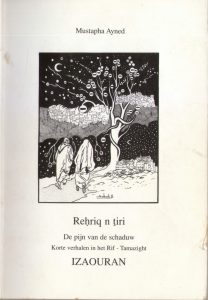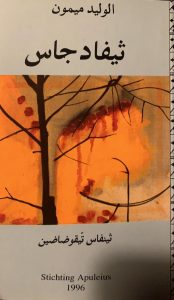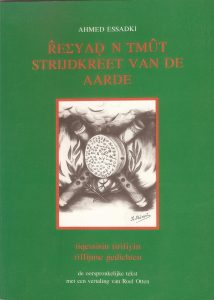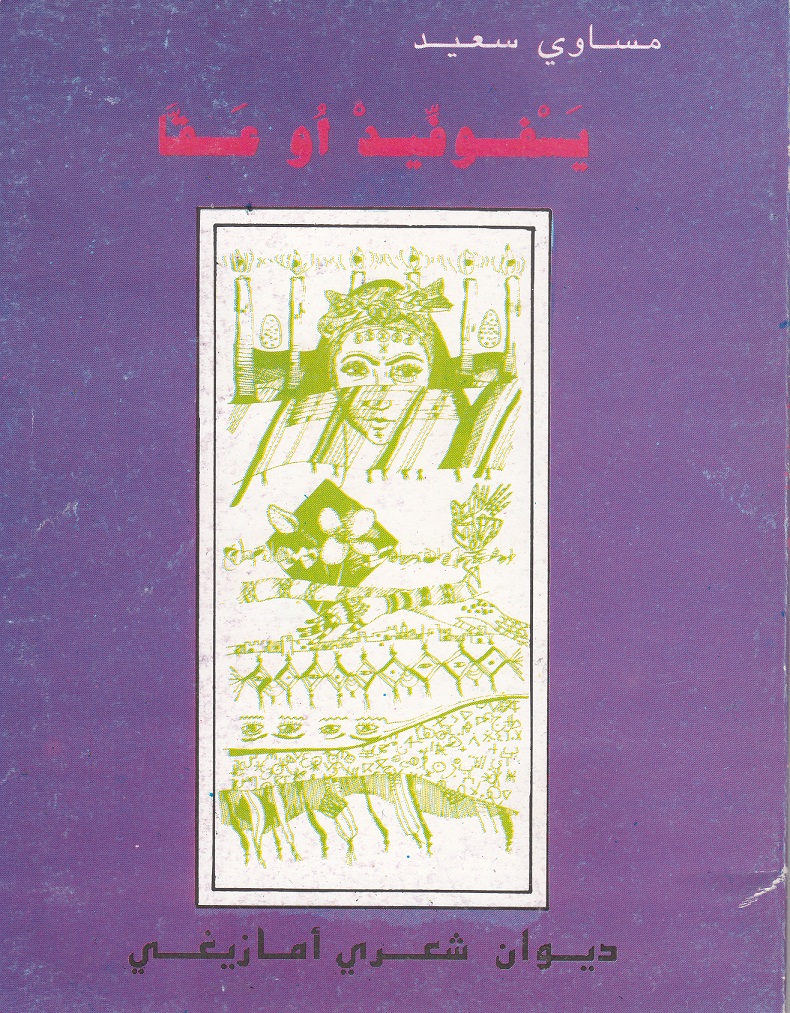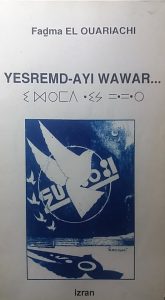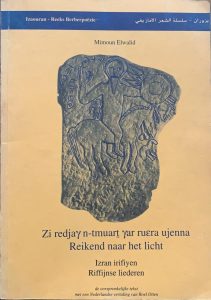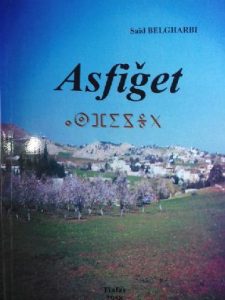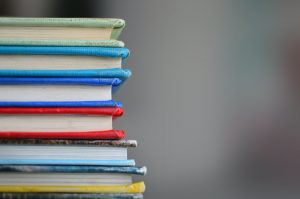These extracts from Riffian Literature are translated for the MULOSIGE project by Mohamed Daoudi.
Amazigh Literature of the Rif in Translation
Translated by Mohamed Daoudi
Novelists, poets and playwrights from the Rif region, in northern Morocco, have usually published their work in the dominant languages in Morocco and the western Mediterranean, namely Arabic and, to a lesser extent, French and Spanish. The beginnings of an Amazigh literature written in Tarifit (the language spoken in the Rif) is a recent phenomenon, which reflects an identity politics generally associated with the cultural revivalism of the late 1970s, although actual published works have not begun to appear in bookstores until the early 1990s. The first poetry collection to be published was Sellam Semghini’s Do You Feel My Pain (Ma-thucid ag rehriq inu) which came out in 1992. It should be noted, however, that some of the poems published in the 1990s have already been popular in the late 1970s and 1980s, that is, before their publication in print, since they were rendered in songs by leading bands and singers (e.g. Ithran, Irizam, Khalid Izri). Since the early 1990s, the publication of works of fiction, novels and short story collections, and poetry has known a relatively steady increase, although Amazigh literary production and reception in the Rif remain limited (Benakeia 2019: 32).
Poetry, however, remains predominant in comparison to other genres, followed by the short story. This predominance attests to the continuing significance of oral culture. Improvised rhyming couplets (called izran) have been one the most prominent forms of traditional poetic expression. These izran usually revolve around the traditional themes of love and heartbreak, social ills, as well as themes that are closely tied to daily life in a sedentary agriculturalist society. But they have also reflected political and economic realities and realities of war. In the translated Riffian texts published on the MULOSIGE website, one of the poems (the only one in the selection that has not been published) is, in fact, a compilation of rhyming couplets sung in the Rif during the Spanish Civil War (1936-39). Hasan El-Farissi (aka. Hasan Thidrin) had heard them from his mother and compiled them into a poem he titled “Taziri Tamiri” (Shining Moon in Love). By telling the story of a love that has been interrupted, read crushed, by the ugliness and brutality of war, this poem catches the devastating effects of the massive participation of Riffian conscripts who were coerced and lured by the Spanish colonial authorities and local Qaids (commanders) loyal to the fascist military officers, into participating in a war in a foreign land.
Published poetry in recent decades, however, as can be seen in the other four poems included in the translated corpus, can be considered a modernist moment in Riffian poetry, as it generally departs from the traditional izran in both form and content. In terms of form, it does not follow the rhyming patterns. In terms of content, it is a “protest” poetry which channels a sense of Amazigh and Riffian identity, and an activism around cultural and linguistic issues becoming more pronounced in Morocco over the past four decades. Like most written Amazigh literature of the last decades, it can be defined as “oppositional” vis-à-vis the dominant political discourse (Benhakeia 2019: 37).
These poems deal with the themes of historical marginalisation, oppression, linguistic and cultural emancipation, the homeland, history and identity. El-Oualid Mimoun, who has written and sung about exploitation, marginalisation, homeless children and the suffering of the working class and the outcasts of society, denounces in his poem “O Thunder” (“A yajjaj”) the exploitation by the dominant classes, and the invisibility of the poor and the downtrodden. Said el-Moussaoui’s poem “We Have Come Feasting for Tomorrow” (“Narzfed ɣar thiwecca”) stresses the inevitability of change and the coming emancipation of a people and a culture that have been oppressed and marginalised for decades. The same determination and optimism in the struggle for emancipation is reflected in Fadma El Ouariachi’s “My Poem” (“Taqessist inou”), which is a manifesto to the empowering and emancipatory potential of language. The title of the collection (Yesremd-ayi wawar) can be translated both as “Speech taught Me” or “The Word Taught Me.” The link that El-Ouariachi posits between this potential and certain metaphors like the henna of the little girls and healing, a function usually associated with Riffian women, suggests women’s central role in the articulation and communication of the word, and of speech. This can be seen as a continuation of the role that women have had in improvising and passing traditional izran across generations. El-Ouariachi’s poem in this sense is an articulation of the idea that women are the “carriers of culture” in Riffian and Amazigh society. Ahmed Essadki’s poem “Ziyan Digging for His Roots” (“Ziyan ixebcen x izwran”) is a poem about one of the most important markers of collective identity in the Rif, namely the history of the struggle against colonialism, a struggle led by Abd-el-Krim El-Khattabi in the early 1920s against both the Spanish and French colonial armies. El-Khattabi established an autonomous rule over most of northern Morocco until the alliance of the French and Spanish armies with hundreds of thousands of troops and the most sophisticated weapons, including massive chemical air bombing campaigns, the first in history, put an end to this fledgling liberation movement in 1926-1927 (Balfour: 123-156). The poem reflects the quest of the new generations for a sense of identity that takes pride in the history of the region, and attempts to rescue it from the marginalisation and oblivion to which it has been subjected in textbooks, the media and official Moroccan historiography.
One of the recurrent themes in Riffian protest poetry, as can be detected in these poems, is the theme of the homeland and the earth. This is also symptomatically reflected in the three short stories included in the Riffian texts, albeit each with a different focus. Ayned’s “Aliens in their Own Land,” a story of an unemployed young man (most probably a university graduate) who lives in the countryside and visits the city as a pastime, reflects how unemployment and the absence of opportunities exacerbate social tensions within a patriarchal family. The feeling that nothing ever happens in the village and the desire to see the world outside anticipate the search for alternatives. In an atmosphere of economic hardship and political repression, one of these alternatives could be the hazardous journey to Europe across the Mediterranean which is the subject of El-Oualid Mimoun’s short story “The Seagull” (“Rɣawiyyeth”). Said Belgharbi’s “Concrete that Has Defaced the Hamlet” (“Tsima iccin udem i dcar”) deplores the gradual transformation of the landscape in Riffian villages and the chaotic urbanization that seals the fate of the relatively autonomous agricultural system of old, an idea which is also implied in Ayned’s story through the broken wooden plough and the protagonist’s inability or unwillingness to follow in his father’s steps and work in the fields. Ironically, the concrete in Belgharbi’s short story, a reference to newly built houses, is one of the direct impacts brought about by the new affluence of families with migrant members in Europe (Lazzar 1987; 2013).
This loss of an important element of identity in the Rif, which is the attachment to the land, explains the nostalgia that permeates much of Riffian literature. The acceleration of international migration in the aftermath of economic depravity and periodic cycles of revolt and repression (1959, 1984 and 2017) has intensified this sense of loss. Interestingly, some of the pioneering work in Riffian literary production has come from the Riffian diaspora in Europe, particularly in the Netherlands. The first Riffian novel in Tarifit written by the late Mohamed Chacha under the title Rez ttabu ad teffegh t fuct (Break the Tabu and Let the Sun Come Out) was published in Amsterdam in 1997. Chacha has published two more novels as well as poetry and short stories. Similarly, the first short story collection in Tarifit, The Great Flood (Rhemreth tameqrant) by Bouzian Moussoui, was published in Amsterdam in 1994.
Acknowledgments:
I would like to thank all the authors and poets whose texts are included in this selection for kindly offering their unconditional support of, and consent to, the publication of these translations. I benefited enormously from the conversations I had with them, and which made the translation process less daunting. I am also indebted to many people who have been instrumental, offering suggestions and helpful tips during the process of text selection, finding the texts, or facilitating the contact with the poets and authors, etc. I would like to mention first and foremost the enormous help from Labib Fahmy during the whole translation process. Special thanks also go to El Yamani Kassouh and Mohamed Amine Benamraoui for their assistance and availability whenever needed. Farid el Hamdioui, Samir Benabdellah, Jamal Abarnous, Abdel-Hamid Taoufik and Mohamed el-Jettari have also been helpful. Last but not least, my most sincere gratitude goes to Itzea Goikolea-Amiano at MUSILOGE for her assistance during this whole process. Jack Clift proofread the translations and offered corrections and suggestions.
Transliteration:
The original Amazigh texts of the Rif are transcribed in Latin script with the following additional symbols:
ɛ: a pharyngeal fricative produced by pressing the root of the tongue against the back of the throat (a sound equivalent to the Arabic letter ع).
ɣ: a voiced velar fricative, equivalent to the Arabic غ
x: a voiceless velar fricative, equivalent to the Arabic خ
c: the voiceless palato-alveolar fricative that corresponds to the English “sh” sound /ʃ/


